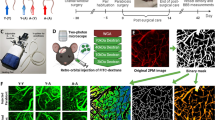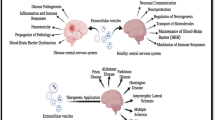Summary
The pathways and mechanisms by which edematous fluid accumulation in the extracellular space (ECS) clears from brain are poorly understood. The objective of this study was to explore, using immunocytochemical technique, the fate of a proteinaceous fluid added to the brain ECS and to study the clearance pathways. The protein movement of this edema fluid was investigated using the direct infusion model on rats. Rat albumin (20 μl) was slowly infused into the caudate-putamen of anesthetized adult rats and the spread and clearance of the edema was followed in various brain regions using immunocytochemical and conventional light and electron microscopy at 0, 1, 2, 3, 4, 6, and 8 days post-infusion. Our studies showed that protein-rich edema fluid cleared slowly from the brain, with 8 days required for the infusion albumin to exit completely from the brain parenchyma. Immediately following infusion, the albumin was distributed in the ECS of the white matter and the overlying deep cortical layers related to the infusion site. During the next 24 h, more of the infused albumin traveled through the ECS to the cortical surface where the albumin passed through the glia limitans to reach the subarachnoid front. Additionally, at 48 h post-infusion, that albumin, which had migrated to the ventricular wall, cleared from the ECS of the subependymal white matter and the ependymal clefts to reach the ventricular cerebrospinal fluid (CSF). In edematous regions, the perivascular spaces of venules and veins were filled with reaction product. Continuity of this perivascular reaction product existed from the deep edematous area to the temporobasal subarachnoid space from where the reaction product gradually disappeared from the parenchyma. From these studies we infer that during the late state of the resolution process the edema front moves toward both the ventricle and the cortical surface to reach the CSF. Thus, among the potential routes for edema clearance, the pathways leading to CSF clearance of fluid predominated. During this clearance process, neither neurons, glia nor the vascular endothelium showed any endocytotic response to the infused albumin throughout the 8-day course. We conclude from these observations that the CSF pathway is the major route of protein-rich edema clearance, when such clearance is not complicated by any concomitant CNS perturbation.
Similar content being viewed by others
References
Baethmann A, Maier-Hauff K, Kempski O, Unterberg A, Wahl M, Schürer L (1988) Mediators of brain edema and secondary brain damage. Crit Care Med 16:972–978
Baker RN, Cancilla PA, Pollock PS, Frommes SP (1971) The movement of exogenous protein in experimental cerebral edema. An electron microscopic study after freeze-injury. J Neuropathol Exp Neurol 30:668–679
Barbosa-Coutinbo LM, Hartmann A, Hossmann K-A, Rommel T (1985) Effect of dexamethasone on serum protein extravasation in experimental brain infarcts of monkey. An immunohistochemical study. Acta Neuropathol (Berl) 65:255–260
Becker NH, Hirano A, Zimmerman HM (1968) Observations of the distribution of exogenous peroxidase in the rat cerebrum. J Neuropathol Exp Neurol 27:439–452
Borison HL, Borison R, McCarthy LE (1980) Brain stem penetration by horseradish peroxidase from the cerebrospinal fluid spaces in the cat. Exp Neurol 69:271–289
Brightman MW (1965) The distribution within the brain of ferritin injected into cerebrospinal fluid compartments. I. Ependymal distribution. J Cell Biol 26:99–123
Brightman MW (1965) The distribution within the brain of ferritin injected into cerebrospinal fluid compartments. II. Parenchymal distribution. Am J Anat 117:193–220
Brightman MW (1968) The intracerebral movement of proteins injected into blood and cerebrospinal fluid of mice. Prog Brain Res 29:19–37
Brightman MW, Klatzo I, Olsson Y, Reese TS (1970) The blood-brain barrier to proteins under normal and pathological conditions. J Neurol Sci 10:215–239
Broadwell RD (1989) Transcytosis of macromolecules through the blood-brain barrier: a cell biological perspective and critical appraisal. Acta Neuropathol 79:117–128
Cotran RS, Karnovsky MJ (1967) Vascular leakage induced by horseradish peroxidase in the rat. Proc Soc Exp Biol Med 126:557–561
Cserr HF (1975) Bulk flow of cerebral extracellular fluid as a possible mechanism of CSF-brain exchange. In: Cserr HF, Fenstermacher JD, Fencl V (eds) Fluid environment of the brain. Academic Press, New York, pp 215–224
Cserr HF (1983) Flow of brain interstitial fluid and drainage into cerebrospinal fluid and lymph. In: Ishii S, Nagai H, Brock M (eds) Intracranial pressure. V. Springer-Verlag, Berlin Heidelberg, pp 618–621
Cserr HF, Ostrach LH (1974) Bulk flow of interstitial fluid after intracranial injection of blue dextran 2000. Exp Neurol 45:50–60
Cserr HF, Cooper DN, Milhorat TH (1977) Flow of cerebral interstitial fluid as indicated by the removal of extracellular markers from rat caudate nucleus. Exp Eye Res [Suppl] 25:461–473
Cserr HF, Cooper DN, Suri PK, Patlak CS (1981) Efflux of radiolabeled polyethylene glycols and albumin from rat brain. Am J Physiol 240:F319-F328
Dux E, Dóczi T, Joó F, Szerdahelyi P, Siklós L (1988) Reverse pinocytosis induced in cerebral endothelial cells by injection of histamine into the cerebral ventricle. Acta Neuropathol 76:484–488
Fenstermacher J, Kaye T (1988) Drug “diffusion” within the brain. Ann NY Acad Sci 531:29–39
Flexner LB (1933) Some problem of the origin, circulation and absorption of the cerebrospinal fluid. Q Rev Biol 8:397–422
Groeger U, Marmarou A (1990) The importance of protein content in the edema fluid for the resolution of brain edema. Acta Neurochir (Wien) (in press)
His W (1865) Über ein perivasculäres Canalsystem in den nervösen Centralorganen und über dessen Beziehungen zum Lymphsystem. Z Wiss Zool 15:127–141 (cited from [16])
Hossmann K-A, Hürter T, Osclies U (1983) The effect of dexamethasone on serum protein extravasation and edema development in experimental brain tumors of cat. Acta Neuropathol (Berl) 60:223–231
Hultström D, Tengvar C, Forssén M, Olsson Y (1984) Distribution of exudated FITC-dextrans in experimental vasogenic brain edema produced by a focal cryogenic injury. Acta Neuropathol (Berl) 63:13–17
Johansson G, Li C-L, Olsson Y, Klatzo I (1970) The effect of acute arterial hypertension on the blood-brain barrier to protein tracers. Acta Neuropathol (Berl) 16:117–124
Klatzo I, Miquel J (1960) Observations in pinocytosis in nervous tissue. J Neuropathol Exp Neurol 19:475–481
Klatzo I, Miquel J, Otenasek R (1962) The application of fluorescein labeled serum proteins (FLSP) to the study of vascular permeability in the brain. Acta Neuropathol 2:144–160
Klatzo I, Miquel J, Ferris PJ, Prokop JD, Smith DE (1964) Observation in the passage of the fluorescein-labelled serum proteins (FLSP) from the cerebrospinal fluid. J Neuropathol Exp Neurol 23:18–35
Klatzo I, Chui E, Fujiwara K, Spatz M (1980) Resolution of vasogenic brain edema. Adv Neurol 28:359–373
Marmarou A, Tanaka K, Shulman K (1982) The brain response to infusion edema: dynamics of fluid resolution. In: Hartmann A, Brock M (eds) Treatment of cerebral edema. Springer-Verlag, Berlin Heidelberg, pp 11–18
Marmarou A, Nakamura T, Tanaka K, Hochwald GM (1984) The time course and distribution of water in the resolution phase of infusion edema. In: Go KG, Baethman A (eds) Recent progress in the study and therapy of brain edema. Plenum Press, New York, pp 37–44
Milhorat TH, Davis DA, Hammock MK (1983) Cerebrospinal fluid as reflection of internal milieu of brain. In: Wood JH (ed) Neurobiology of cerebrospinal fluid, vol 2. Plenum Press, New York, pp 1–23
Ogata J, Hochwald GM, Cravioto H, Ransohoff J (1972) Distribution of intraventricular horseradish peroxidase in normal and hydrocephalic cat brains. J Neuropathol Exp Neurol 31:454–463
Olsson Y, Hossmann K-A (1970) Fine structural localization of exudated protein tracers in the brain. Acta Neuropath (Berl) 16:103–116
Rennels M, Gregory TF, Blaumanis OR, Fujimoto K, Grady P (1985) Evidence for a “paravascular” fluid circulation in the mammalian central nervous system, provided by the rapid distribution of tracer protein throughout the brain from the subarachnoid space. Brain Res 326:47–63
Reulen HJ, Graham R, Spatz M, Klatzo I (1977) Role of pressure gradients and bulk flow in dynamics of vasogenic brain edema. J Neurosurg 46:24–36
Reulen HJ, Tsuyumu M, Tack A, Fenske AR, Prioleau GR (1978) Clearance of edema fluid into cerebrospinal fluid. A mechanism for resolution of vasogenic edema. J Neurosurg 48:754–764
Salahuddin TS, Kalimo H, Johansson BB, Olsson Y (1988) Observations on exudation of fibronectin, fibrinogen and albumin in the brain after carotid infusion of hyperosmolar solutions. An immunohistochemical study in the rat indicating longlasting changes in the brain microenvironment and multifocal nerve cell injuries. Acta Neuropathol 76:1–10
Tengvar C (1986) Extensive intraneuronal spread of horseradish peroxidase from a focus of vasogenic edema into remote areas of central nervous system. Observations in mouse central nervous system subjected to cortical cold injury. Acta Neuropathol (Berl) 71:177–189
Tengvar C, Olsson Y (1982) Uptake of macromolecules into neurons from a focal vasogenic cerebral edema and subsequent axonal spread to other brain regions. A preliminary study in the mouse with horseradish peroxidase as a tracer. Acta Neuropathol (Berl) 57:233–235
Turner PT, Harris AB (1974) Ultrastructure of exogenous peroxidase in cerebral cortex. Brain Res 74:305–326
Van Deurs B (1977) Vesicular transport of horseradish peroxidase from brain to blood in segments of the cerebral microvasculature in adult mice. Brain Res 124:1–8
Vass K, Lassmann H, Wisniewski HM, Iqbal K (1984) Ultracytochemical distribution of myelin basic protein after injection into the cerebrospinal fluid. Evidence for transport through the blood-brain barrier and binding to the luminal surface of cerebral veins. J Neurol Sci 63:423–433
Vorbrodt AW, Lossinsky AS, Wisniewski HM, Suzuki R, Yamaguchi T, Masaoka H, Klatzo I (1985) Ultrastructural observations on the transvascular route of protein removal in vasogenic brain edema. Acta Neuropathol (Berl) 66:265–273
Wagner H-J, Pilgrim Ch, Brandl J (1974) Penetration and removal of horseradish peroxidase injected into the cerebrospinal fluid: role of cerebral perivascular spaces, endothelium and microglia. Acta Neuropathol (Berl) 27:299–315
Wilmes F, Hossmann K-A (1979) A specific immunofluorescence technique for the demonstration of vasogenic brain edema in paraffin embedded material. Acta Neuropathol (Berl) 45:47–51
Wolman M, Klatzo I, Chui E, Wilmes F, Nishimoto K, Fujiwara K, Spatz M (1981) Evaluation of the dye-protein tracers in pathophysiology of the blood-brain barrier. Acta Neuropathol (Berl) 54:55–61
Wood JH (1980) Physiology, pharmacology and dynamics of cerebrospinal fluid. In: Wood JH (ed) Neurobiology of cerebrospinal fluid, vol 1. Plenum Press, New York, pp 1–16
Author information
Authors and Affiliations
Additional information
Supported in part by grants NS-19235, NS-20193 and NS-12587 from the National Institutes of Health. Additional facilities and support were provided by the Richard Roland Reynolds Neurosurgical Research Laboratories
Rights and permissions
About this article
Cite this article
Ohata, K., Marmarou, A. & Povlishock, J.T. An immunocytochemical study of protein clearance in brain infusion edema. Acta Neuropathol 81, 162–177 (1990). https://doi.org/10.1007/BF00334505
Received:
Revised:
Accepted:
Issue Date:
DOI: https://doi.org/10.1007/BF00334505




